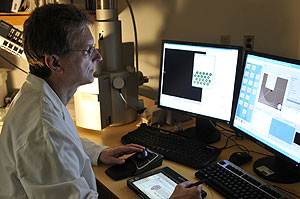DENVER, May 12, 2010 – On television shows such as “CSI: Crime Scene Investigation” and “Law and Order,” forensic science offers high drama. But the reality is different. Most crime-scene analysis is routine, and more about meticulous record-keeping than midnight revelations. But one crime lab has taken much of the tedium out of the job by using the productivity tools that come with Microsoft Office 2010.

Colorado Bureau of Investigation analyst Alex Rugh looks for traces of chemicals on a piece of evidence from a crime scene using a scanning electron microscope.
The Colorado Bureau of Investigation (CBI), under its Forensic Services division, operates five crime labs throughout the state. In 2009, it analyzed nearly 100,000 bullets, blood samples, fingerprints, DNA specimens and other types of crime-scene evidence. For each one, the 80 forensic scientists had to conduct a variety of tests with zero tolerance for errors, generate a report for the police and the courts, and maintain stringent chain-of-custody records to prove the evidence hadn’t been tampered with.
Until 2008, these were largely manual and paper-based processes, and the division was accumulating a growing backlog of work. That’s when CBI started using a laboratory information management system (LIMS) developed by the solutions provider and Microsoft Gold Certified Partner Forensic Advantage Systems. That LIMS, called Forensic Advantage, was designed to work with Microsoft Office 2007. In 2009, Forensic Advantage Systems updated its LIMS to interoperate with Microsoft Office 2010 Professional. That’s when CBI became an early adopter of the upgraded solution.
CBI is testing the new LIMS and Office 2010 Professional in three of its forensic labs, and plans to deploy it to all 80 Forensic Services analysts by September. But the benefits are already clear, says Chet Ubowski, quality assurance manager for the Forensic Services Division. “We’ve been able to reduce the time we spend on each case, significantly cut our case backlog and improve collaboration among our staff,” he says.
Automating Processes
Almost every step on the process of receiving evidence, testing it and reporting back to local law enforcement has benefitted from the new LIMS, which exploits most of the features of Office 2010.
One of the new Office tools that has proven most useful at CBI is InfoPath 2010. This application creates timesaving and paper-saving electronic forms, which automatically populate certain boxes when, for example, a lab worker has to log in multiple samples from the same crime scene. This not only saves time, but reduces the likelihood of typographical errors that could impact the outcome of a case.
InfoPath also helps CBI manage the stringent chain-of-custody, accreditation and evidence-discovery reporting requirements associated with criminal investigations.
Excel 2010 has also proven to be a major timesaver, says Ubowski. “We’ve been able to use the increased functionality in Excel 2010 to drive automated batch-processing routines for some of our lab equipment, like our gas chromatographs,” he says. “Excel can send instructions to the instruments and import results data directly from them. We used to have to copy data off of instruments’ screens and write it on paper forms. This was an opportunity to transpose numbers or make other mistakes.” Ubowski estimates that implementing machine-to-machine communication has cut the error rate in his labs by between 5 percent and 15 percent.

The Colorado Bureau of Investigation turned to Office 2010 as part of a system that has dramatically reduced backlog at its five crime labs.
To save even more time, the Forensic Advantage LIMS feeds results from the InfoPath forms into a SQL database, which in turn generates reports based on those results in the form of a Word document using preformatted phrases. The analyst just has to proofread the report to ensure its accuracy. “I can’t tell you how many times we used to have to type stock statements like ‘Item number 3 was found to contain traces of cocaine, a Schedule II controlled substance,’” says Ubowski.
CBI analysts also use PowerPoint 2010 and Visio 2010, a drawing and diagramming tool, to create more formal reports and presentations that include graphs and charts. “This has made our reports more flexible and easier for police officers, prosecutors, defense lawyers and juries to understand,” says Ubowski.
According to Ubowski, Office also helps scientists collaborate more effectively. A complicated case could easily involve a dozen different specialists, including chemists, serologists and ballistics experts. CBI analysts now use a variety of applications in Office 2010 to share information and collaborate with colleagues who may work in different cities, including Outlook e-mail, Communicator instant messaging and LiveMeeting videoconferencing.
Finally, CBI is now able to send results securely to police departments through a secure document delivery system. “With Office 2010 and the Forensic Analysis LIMS, we’ve been able to become an almost entirely paperless operation,” says Ubowski.
Taking a Bite Out of Backlogs
Forensic scientists and technicians at CBI can now complete analyses and return results quickly, reducing the agency’s case backlog and making it easier to meet court deadlines. After adopting Forensic Advantage in 2008, for example, the drug-chemistry unit in Forensic Services reduced its backlog from 4,000 to 800 samples.
“What more accurate and timely analyses and more robust reports add up to is both a cost savings for the state of Colorado, and a better chance that we can apprehend and convict criminals who otherwise might still be prowling our streets,” says Ubowski. “That’s a good feeling.”




